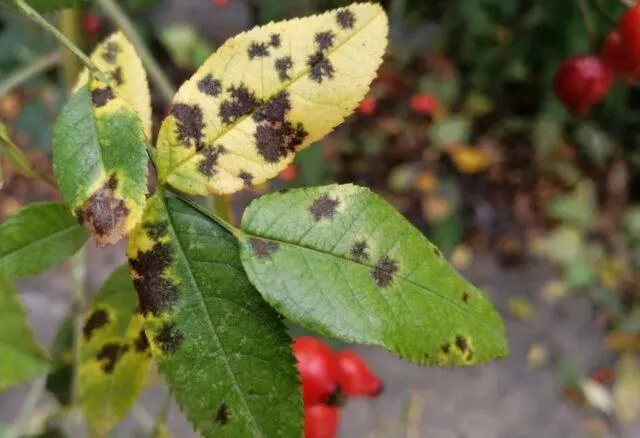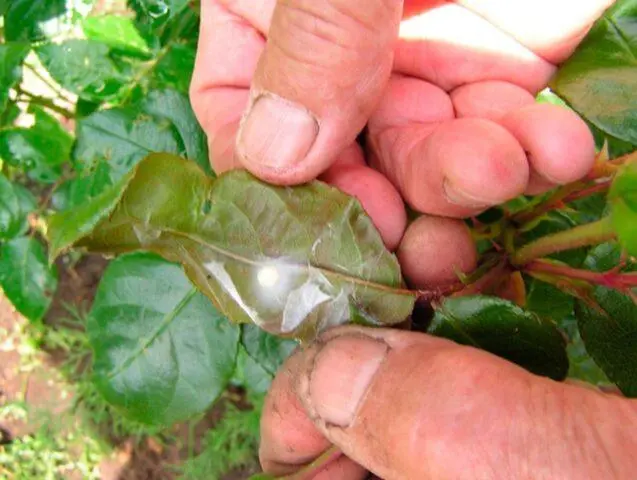Contents
White rosehip is an ornamental plant with a beautiful summer bloom. The culture is represented by many varieties and has low care requirements.
Is there a white rosehip
Most varieties of wild rose bloom with pink and red buds. However, there are also white varieties, in the garden they look especially impressive. Such rose hips are very popular in decorative breeding, and the process of growing it is no different from the standard one.
What does white rosehip look like and is called?
In nature, white inflorescences are brought by rose hips (Rosa multiflora). A plant from the Rosaceae family is a shrub with long climbing shoots covered with reddish-green or brown bark. It has paired curved spikes up to 6 mm. The leaves of the plant are compound, consisting of an odd number of elliptical or obovate leaflets with pubescence below.

In height, the white dogrose rises to an average of 2 m
In early summer, the multi-flowered wild rose produces small white or slightly pinkish buds in pyramidal-paniculate inflorescences. By autumn it gives fruits – elongated dark red berries with light brown triangular seeds inside.
White rosehip grows in Japan, Korea and Taiwan. It is distributed mainly along the banks of rivers, on slopes and in shrubbery, prefers sunny areas, but can also grow in partial shade.
Types and varieties of wild rose with white flowers
There are a lot of names and photos of wild rose with white flowers – in gardening, the shrub is represented by numerous hybrids. Varieties most often have terry buds, which in appearance are very reminiscent of a rose.
White Pavement
Variety White Pyvment reaches 1,2 m above the ground. It has beautiful dark green leaves, blooms from early to late summer. In the photo of a blooming white rosehip, you can see abundant golden stamens in the center of semi-double buds. In the fall, it sets small orange-red fruits that maintain the decorative effect of the plant until the cold weather.

During the flowering period, White Pavement emits a pleasant sweet aroma.
Waterloo
The medium-sized Waterloo variety rises to an average of 1,5 m. It is distinguished by very abundant flowering, large buds up to 3 cm in diameter, collected in thick brushes. Prefers light areas, has high frost resistance and tolerates temperatures down to -25 ° C.
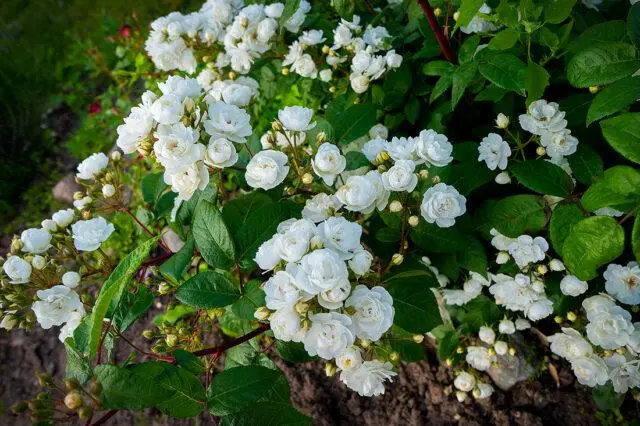
In good conditions, Waterloo can bloom again in the fall.
Suaveolens (Suaveolens)
A very beautiful white rosehip, similar to a rose, is able to rise up to 3 m, spreads over 2 m in diameter. A thorny shrub with dark green leaves with a bluish tint. During the summer it brings white flowers up to 6 cm with an openwork pattern, emits a rich fruity aroma. It can take root in Siberia, as it can withstand frosts down to -40 ° C.
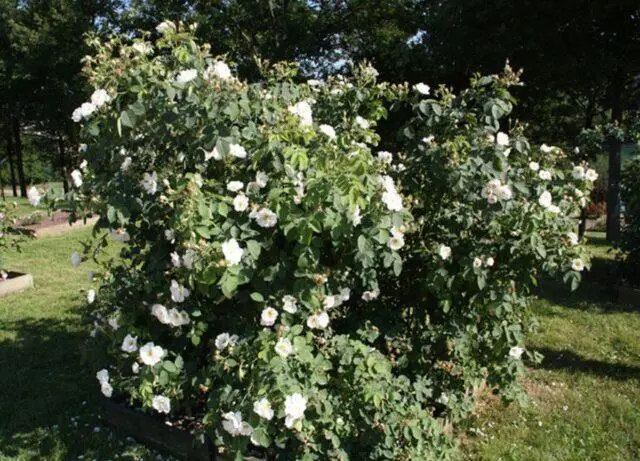
The white variety Suaveolens rarely suffers from rust and powdery mildew.
Madame Plantier
Variety Madame Plantier is a vigorous branched shrub with a small number of thorns. Blooms in early summer. At first, the terry buds of the plant are pale pink, but then they quickly fade to a pure white hue. The flowers are collected in brushes of 5-20 pieces.
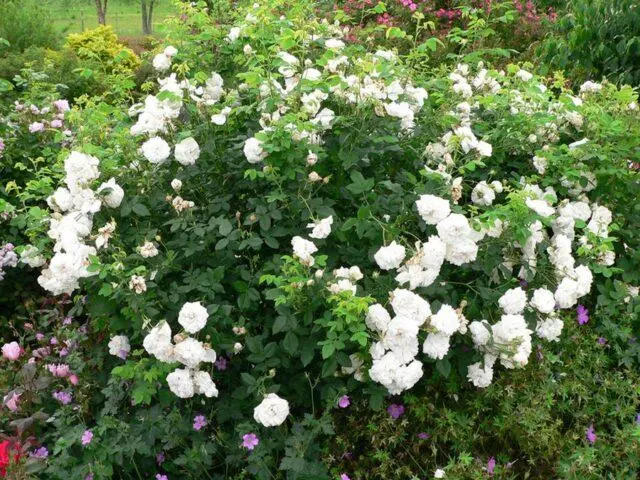
The buds of Madame Plantier have up to 140 petals.
Louise Bugnet
The elegant variety Louise Bagnet has small leaves that are dark green and leathery in texture. The shrub is frost-resistant, has a good immunity to fungi. A photo of a white rose hip in color looks very impressive. Terry buds are wine-red before blooming. But after opening, the upper petals become snow white, while the lower ones remain pinkish or dark cherry.
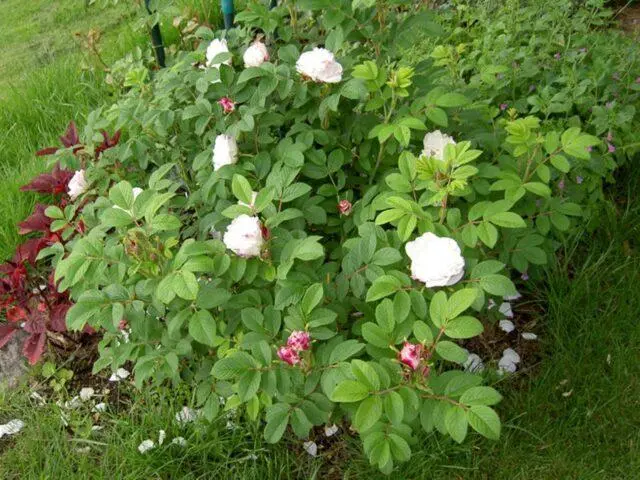
Louise Bagnet rises an average of 1 m above the ground
Lac Mezhu (Lac Majeau)
A vigorous variety in early summer brings large buds in inflorescences up to five pieces. It can grow up to 2 m, retains its decorative effect until mid-September, emits a strong pleasant aroma. In autumn it gives red berries – they have no special medicinal and nutritional value, but they look very attractive on the branches.

Variety Lac Mezhu has almost no thorns
Alba Meidiland
An unpretentious variety from the beginning of June until autumn brings terry small buds in shields up to ten pieces. Spreads 2 m wide, while the height of the shrub is only about 70 cm. It does not require special care and pruning after flowering, since the petals of the plant fall off on their own. Gives off a pleasant, mild fragrance.
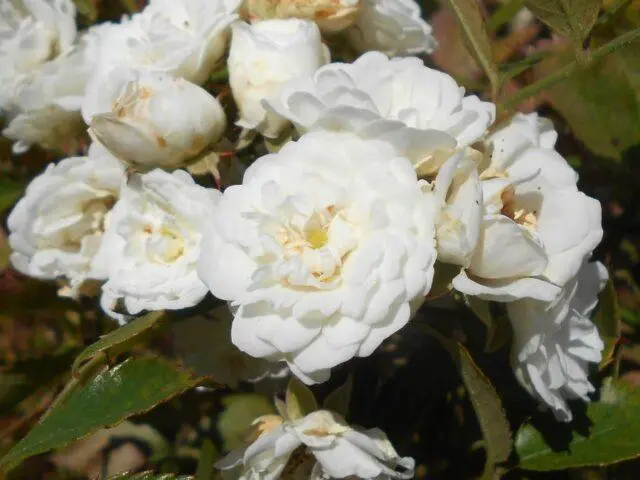
Alba Madiland does not bear fruit
What is useful white rosehip
The benefits of white rose hips are due to its rich chemical composition. The plant is used to prepare decoctions and infusions, and all parts are taken as raw materials – fruits, flowers and leaves. When used in moderation, white rose hips:
- accelerates recovery from colds and strengthens the immune system;
- improves the functioning of the nervous and cardiovascular systems;
- strengthens hair and promotes skin rejuvenation;
- increases the level of hemoglobin and prevents the development of anemia;
- relieves irritation of mucous membranes and accelerates the healing of lesions;
- removes toxins from the intestines;
- cleanses the liver and protects the organ from inflammation;
- improves appetite and speeds up metabolic processes.
You can use white rose hips to lower blood pressure and normalize cholesterol levels. Decoctions and infusions of the plant prevent the development of cardiovascular diseases and increase the endurance of the body.
Planting and caring for white rose hips
The cultivation of white rose hips is carried out according to standard algorithms. The main attention should be paid to watering and soil composition, as well as regular pruning of shrubs.
Site and soil requirements
White dogrose prefers well-lit areas located on a hill away from groundwater. The roots of the plant go deep into the soil, so in wetlands the shrub often suffers from rot and fungal diseases. It is not recommended to plant a crop on acidic soils.
How to plant a white rosehip
It is recommended to plant wild rose bushes with white flowers in the autumn period – in October or early November. The procedure looks like this:
- At the selected site, they dig up and, if necessary, lime the soil. A hole about 30 cm deep is prepared for the plant, compost and rotted manure are added to it, as well as sand for good moisture removal.
- The shoots of a white rosehip seedling are cut to 10 cm, and the roots are shortened to 15 cm. Shortly before planting, the underground part is dipped in a clay mash.
- The plant is lowered into the prepared hole and the roots are straightened. The hole is filled to the top with the remains of a mixture of garden soil, compost and manure, the soil is compacted and watered properly. To slow down the evaporation of moisture, white rose hips can be immediately mulched with peat or sawdust.
When planting several seedlings, 1-1,5 m of free space is left between them. If a hedge is to be formed with the help of a shrub, the distance is reduced to 50 cm.

It is necessary to deepen the white rosehip when planting by 5-8 cm
How to care for white rose hips
Growing white rose hips is quite simple – the main attention should be paid to watering and top dressing. In the first year after planting, the shrub is regularly moistened – at least twice a month in the absence of rain. At the same time, 25-30 liters of water should go to a young plant, and up to 50 liters to an adult.
In the first two years of cultivation, white rose hips do not require top dressing. For the third season, you can add 120 g of nitrogen-containing fertilizers to the soil in spring and summer, and add 170 g of phosphorus and potassium for each bush in the fall. It is also recommended to water the plant from time to time with infusion of chicken manure or slurry.
Pruning white rosehip
In order for the flowering of the white rosehip to be plentiful, and the plant itself to keep a neat shape, it needs to be trimmed regularly. For the first time, pruning is carried out in the third year after planting – a bush is formed from 15-20 branches of different ages. Shoots older than seven years are removed entirely, they bear fruit poorly and bloom not so profusely.
On an annual basis, a sanitary haircut is performed for the shrub. In the process, all dried, broken and twisted branches are removed that spoil the outlines of the plant and interfere with its development.
How to transplant white rosehip
Transplantation of white rosehip shrubs is carried out in October-November or early spring before the juices begin to move. The procedure looks like this:
- On the site, a new place for the shrub is prepared in advance, the soil is loosened and fertilized.
- An adult plant is carefully dug in a circle and removed along with an earthen clod, trying not to injure the roots.
- The shrub is immediately transferred to a new hole, covered with soil and watered abundantly.
For the procedure, you need to choose a cloudy and fairly cool day. In the heat and in the bright sun, the white dogrose takes root in a new place poorly.
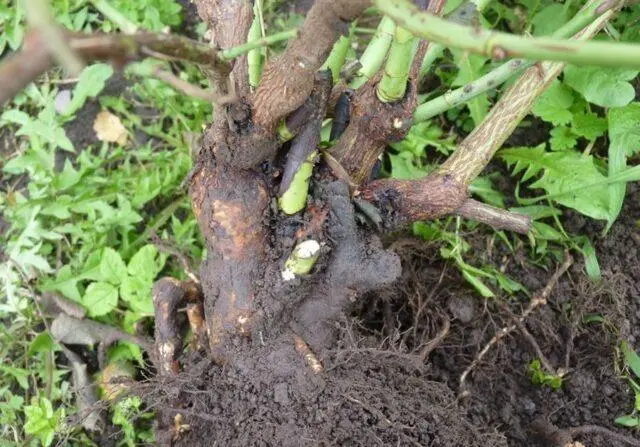
If the roots of the rosehip were injured during transplantation, the wounds should be sprinkled with wood ash
How to root and propagate white rosehip
Reproduction of white rose hips on the site is carried out in several ways. Vegetative methods are considered the most convenient, but it is also possible to grow a culture from seeds.
Green cuttings
The easiest and most effective way is to use green plant cuttings. The algorithm looks like this:
- In spring, annual flexible shoots up to 10 cm long are cut from an adult bush.
- Three internodes are left on the cuttings, the lower leaves are completely removed.
- With an oblique cut, the shoots are immersed for a day in a solution of Kornevin or Heteroauxin.
- The cuttings are transferred to peat pots with nutritious soil mixture and covered with a glass jar.
During germination, the shoots are regularly moistened and ventilated. When the cuttings begin to grow, they can be transferred to open ground along with a decomposable pot.
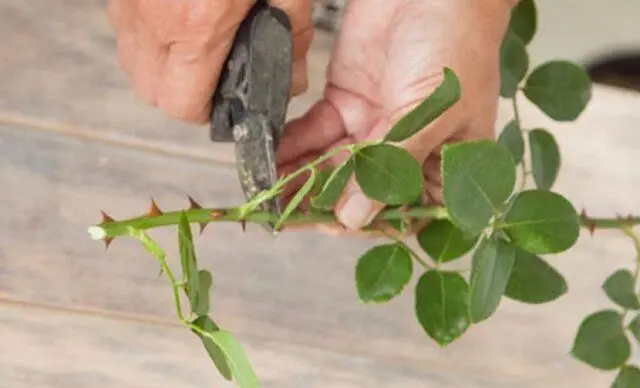
The lower cut of the white rosehip cutting is performed at an angle of 30 degrees
Seeds
The seed method requires a lot of effort from the gardener. The germination scheme is as follows:
- In August or early September, the fruits of the plant are harvested, the seeds are removed and washed from the pulp.
- The material is sown on a temporary bed to a depth of 2,5 cm with a distance of 2 cm between individual seeds.
- Water the site, mulch with sawdust and moisten the soil for several weeks as it dries.
- After the appearance of two true leaves, the seedlings are transferred to a permanent place with a distance of 10 cm between individual shoots.
Seed propagation has a minus – varietal hybrids using this method may lose their unique characteristics.
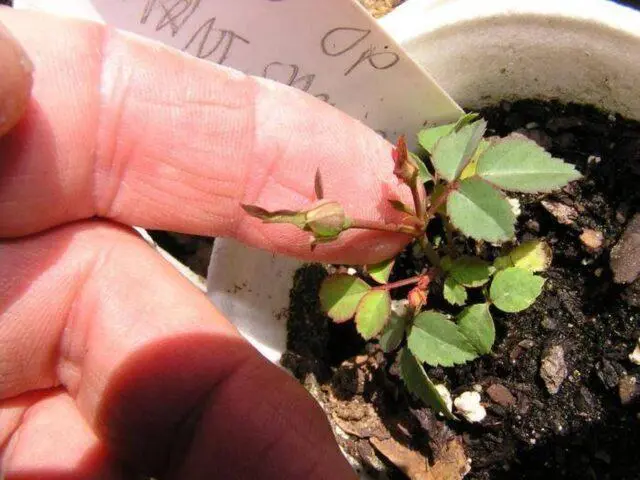
White rosehip can be grown at home in a pot, but it sprouts well in the open field.
Division of the bush
For propagation of adult bushes older than five years, the method of division is usually used. The procedure is very simple:
- White rose hips are dug out of the ground, the soil is shed with water in advance to make it easier to extract the bush.
- With a sharp tool, the rhizome is divided into several parts, trying to leave neat cuts.
- The delenki are immediately planted in prepared holes and watered abundantly until rooting.
On each part of the bush, 2-3 healthy shoots and at least one underground growth point should remain.

It is better to divide the white rosehip before or after the growing season.
Diseases and pests
The description of the white rosehip notes its high resistance to infections. But the plant still suffers from some fungi. Most often, shrubs are affected by:
- powdery mildew – you can recognize the disease by a whitish coating on the leaves;

Powdery mildew interferes with leaf photosynthesis and can lead to crown drop.
- rust – the shoots of the shrub crack and thicken, a dense bright red coating appears on the wound sites, the leaves become covered with orange spots;

Rust often develops in warm and excessively humid weather.
- black spot – a fungal disease leads to the appearance of brown, almost black rounded spots on the leaves, which eventually turn into necrotic areas.

With black spotting, dark areas quickly expand and merge.
Treatment of white rose hips for ailments is usually carried out with copper preparations – Fast, HOM, Bordeaux liquid. Spraying is carried out according to the instructions 3-4 times per season.
Of the pests, the most dangerous for white rose hips are:
- aphid – a small insect reproduces in large colonies and sucks the juice from leaves and shoots;

When infested with aphids, the buds of the white rosehip do not open, and the fruits become small
- leaflet – you can find out about the presence of a pest by leaf plates that wrap inward.

The leaf-roller goes to the wild rose from fruit trees in the neighborhood or from roses
- moth – green caterpillars with brownish spots eat the leaves and buds of the plant, causing it to wilt.

The invasion of the moth on the wild rose occurs in waves at intervals of several years
With a slight damage to the white rosehip by pests, garlic infusion, soap and ash solutions can be used. Caterpillars from leaves and shoots are often harvested by hand. If there are a lot of insects, it is better to resort to insecticides – Karbofos, Decis, Inta-Vir and other chemicals. They are used for spraying at intervals of 1-2 weeks from spring to autumn.
What plants are combined with
White wild rose in the garden looks spectacular next to other flowering shrubs and perennials. You can plant it:
- with geranium and lavender;
- with bells;
- with asters and phlox.
At the same time, it is not necessary to select neighbors with white flowering for the shrub. Rosehip will stand out brightly against the background of red and pink plants. Its beauty is favorably emphasized by dark green plantings.
Conclusion
White rosehip looks beautiful in landscape design and does not require complex care. When growing, it is important to monitor the condition of the soil and water the shrub in time, as well as make periodic top dressing.












